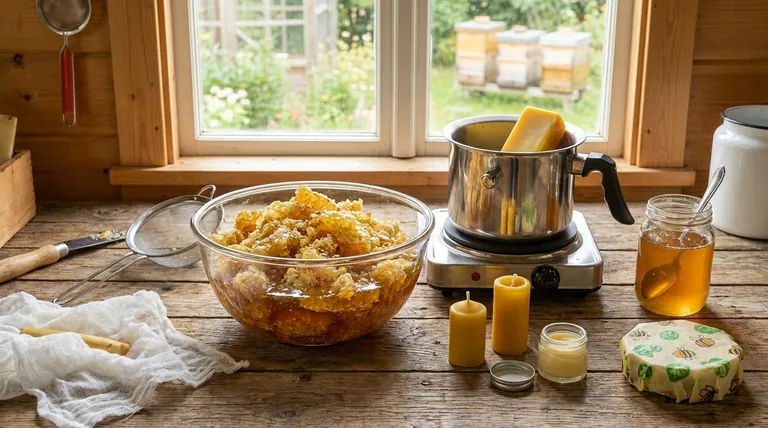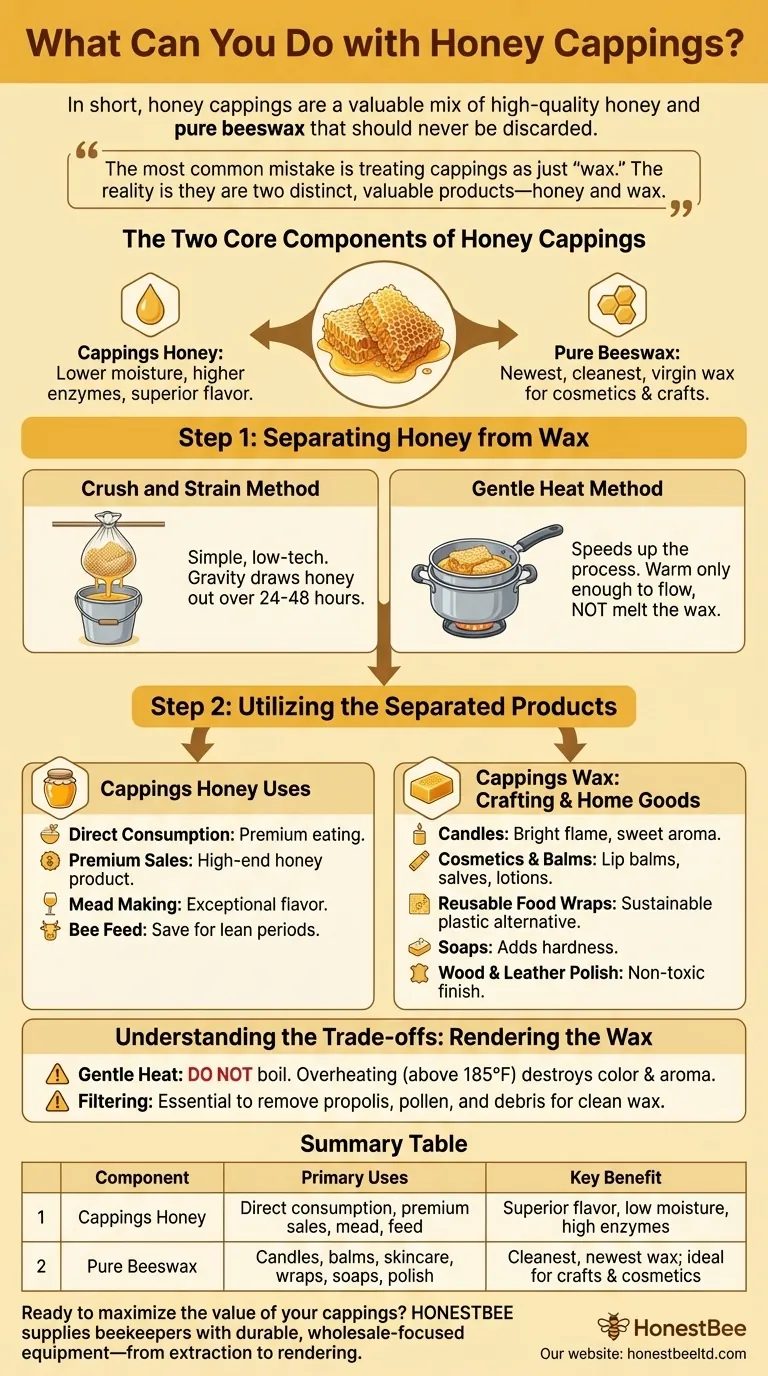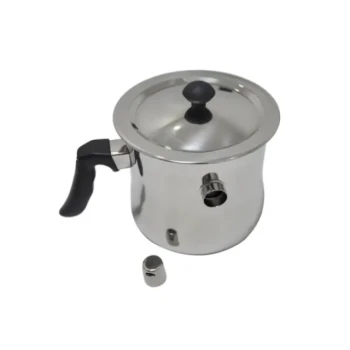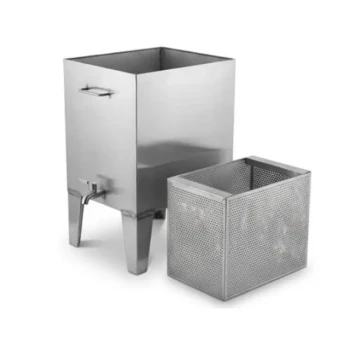In short, honey cappings are a valuable mix of high-quality honey and pure beeswax that should never be discarded. After separating the honey from the wax, you can use the exceptionally pure beeswax to create a wide range of products, including candles, lip balms, skincare lotions, and reusable food wraps. The recovered honey is often considered the most flavorful and is perfect for personal use.
The most common mistake is treating cappings as just "wax." The reality is they are two distinct, valuable products—honey and wax—and the key to unlocking their potential lies in separating them first.

The Two Core Components of Honey Cappings
Before you can use them, you must understand what cappings are. They are not just waste wax; they are a rich combination of two of the hive's finest products.
The Residual Honey
When beekeepers uncap frames for extraction, a significant amount of honey clings to the wax. This "cappings honey" has a lower moisture content and a higher concentration of enzymes and pollen, which many believe gives it a superior flavor and aroma.
The Pure Beeswax
The wax itself is the "virgin" wax that bees create to seal the cells of ripened honey. It is the newest, cleanest, and purest wax in the hive, free from the darker colors and contaminants often found in older brood comb. This makes it highly sought-after for cosmetic and craft applications.
Step 1: Separating Honey from Wax
Your first and most important task is to separate the honey from the wax. You have two primary methods, both of which are effective.
The Crush and Strain Method
This is the simplest, lowest-technology approach. Place your cappings in a fine mesh bag, cheesecloth, or a specialized cappings strainer bag. Suspend this bag over a food-grade bucket and let gravity slowly draw the honey out. This process can take 24 to 48 hours but requires minimal effort.
The Gentle Heat Method
To speed things up, you can introduce gentle warmth. You can place your cappings in a shallow pan inside a solar wax melter or use a double boiler on very low heat. The goal is only to warm the honey enough to flow freely, not to fully melt the wax. As the honey drains, it can be collected.
Step 2: Utilizing the Separated Products
Once separated, you have two high-quality ingredients ready for use.
For the Cappings Honey
The honey you've collected is a premium product. It can be used directly for eating, sold as a high-end honey, or used to make exceptional mead. Some beekeepers also save it to feed back to their bees during lean periods.
For the Cappings Wax: Crafting & Home Goods
After the honey has been drained, the wax needs to be rendered—melted down and filtered—to be used. Once you have a clean block of beeswax, the possibilities are extensive.
- Candles: Cappings wax burns cleanly with a bright flame and emits a naturally sweet, pleasant aroma.
- Cosmetics & Balms: Its purity makes it ideal for lip balms, salves, lotions, and deodorants. It acts as a natural emulsifier and provides a protective barrier for the skin.
- Reusable Food Wraps: By infusing cotton fabric with a melted mixture of beeswax, jojoba oil, and pine resin, you can create sustainable, reusable alternatives to plastic wrap.
- Soaps: Beeswax adds hardness to a bar of soap, helping it last longer.
- Wood and Leather Polish: A simple mixture of melted beeswax and mineral oil creates an excellent, non-toxic polish for wooden cutting boards, furniture, and leather goods.
Understanding the Trade-offs: Rendering the Wax
Rendering is the process of melting and cleaning the wax. This is where quality can be gained or lost.
The Importance of Gentle Heat
Do not boil your beeswax. Overheating the wax (above 185°F or 85°C) will darken its color and destroy its delicate, sweet aroma. Always use a double boiler or a dedicated, temperature-controlled wax melter to keep the heat low and consistent.
The Need for Filtering
Your drained cappings will still contain small impurities like propolis, pollen, and other hive debris. After melting the wax, you must filter it through several layers of cheesecloth or a fine-mesh screen to produce a clean, pure block suitable for crafting. This step is critical for high-quality results.
Making the Right Choice for Your Goal
How you process your cappings depends on your available time and end goal.
- If your primary focus is simplicity: Use the crush and strain method to collect the honey for your personal use. You can store the drained wax in a freezer until you have time for a rendering project.
- If your primary focus is maximizing value: Take the time to separate the honey, then render and filter the wax. This pure beeswax can be sold for a premium or used to create high-value products like cosmetics and candles.
- If your primary focus is supporting your bees: After straining most of the honey, you can place the damp cappings a safe distance from the hive, and the bees will reclaim the remaining honey.
By properly processing your honey cappings, you transform a simple byproduct into two of the hive's most valuable resources.
Summary Table:
| Cappings Component | Primary Uses | Key Benefit |
|---|---|---|
| Cappings Honey | Direct consumption, premium sales, mead making, bee feed | Superior flavor, lower moisture, high enzyme content |
| Pure Beeswax | Candles, lip balms, skincare, food wraps, soaps, polish | Cleanest, newest wax in the hive; ideal for crafts & cosmetics |
Ready to efficiently process your honey harvest and maximize the value of your cappings?
HONESTBEE supplies beekeepers and commercial apiaries with the durable, wholesale-focused equipment needed for every step—from extraction to rendering. Get the strainers, melters, and tools to turn your cappings into profitable products.
Contact our experts today to discuss your operation's needs.
Visual Guide

Related Products
- Beeswax Melter for Candle Making Honey Bee Wax Melter
- Honey Wax Separating Wax Press with Metal Screw Wax Separator Machine
- HONESTBEE 6 Frame Three Use Electric Honey Extractor for Beekeeping
- 8-Frame Electric Self-Reversing Honey Extractor Spinner for Commercial Honey Extraction Equipment
- HONESTBEE 3-Frame Manual Acrylic Honey Extractor
People Also Ask
- How does a steam wax melter work? A Fast, Efficient Method for High-Quality Wax
- What do you use a wax melter for? From Home Fragrance to Professional Beekeeping
- What are the primary products of honey bee farming besides honey? Discover the Hive's Hidden Treasures
- What is the best way to melt beeswax for candles? The Safest Method for Professional Results
- What is the recommended temperature range for melting beeswax? Achieve Perfect Quality & Safety



















